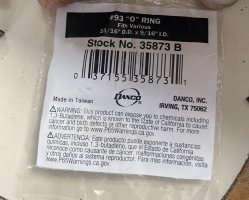Puget sailor
Member II
Just finished rebuilding the Raritan ph2 head on my 32-3. This is the original pre-1992 model, but there is now a universal rebuild kit which includes the parts for pre plus post 1992 versions. There are also kits available that only do one or the other. Be careful! Availability was an issue, but a place called Marine San in Seattle, which sells nothing but marine heads and parts not only had the part, they were also cheaper than other sources. They shipped it same day.
My bowl and discharge parts were disgustingly coated with huge amounts of caked on vacuum deposits. The joker valve was not able to seal because of all the deposits, so the bowl could not be dried, and the crud went quite a ways up. Chipping with screwdriver interspersed with white vinegar soaking, and scrubbing with Barkeepers Friend cleanser, brought it back to like new, amazingly. The latter product is a cleanser with Oxalic acid powder. Works amazing on rust stains, and metal marks, such as the screwdriver lines on the porcelain. Also does a nice job on stainless sinks.
I was perplexed for a while at the lack of water flow into the bowl on flush mode after rebuilding. I studied the layout and concluded the vented loop between the through hull and the pump was a mistake by a prior owner, if not Ericson? It allows too much air to be sucked in through the loop’s tiny duckbill vent during fill strokes to really put much water through the bowl. Doing a little research I came to see that a vented loop is a good idea to avoid bowl flooding, but it needs to go between the pump and bowl, not between the through hull and pump. How it survived this way for so long is a mystery. Not the last one on this boat, no doubt!
My bowl and discharge parts were disgustingly coated with huge amounts of caked on vacuum deposits. The joker valve was not able to seal because of all the deposits, so the bowl could not be dried, and the crud went quite a ways up. Chipping with screwdriver interspersed with white vinegar soaking, and scrubbing with Barkeepers Friend cleanser, brought it back to like new, amazingly. The latter product is a cleanser with Oxalic acid powder. Works amazing on rust stains, and metal marks, such as the screwdriver lines on the porcelain. Also does a nice job on stainless sinks.
I was perplexed for a while at the lack of water flow into the bowl on flush mode after rebuilding. I studied the layout and concluded the vented loop between the through hull and the pump was a mistake by a prior owner, if not Ericson? It allows too much air to be sucked in through the loop’s tiny duckbill vent during fill strokes to really put much water through the bowl. Doing a little research I came to see that a vented loop is a good idea to avoid bowl flooding, but it needs to go between the pump and bowl, not between the through hull and pump. How it survived this way for so long is a mystery. Not the last one on this boat, no doubt!


